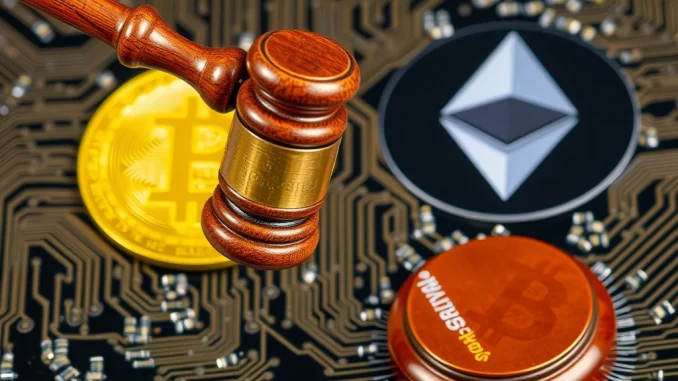
Exciting news for the crypto community! For years, the digital asset space in the U.S. has been navigating murky waters, yearning for clear rules. But hold onto your hats, because Washington D.C. is finally making waves! U.S. Congress is taking a significant leap forward with a bipartisan framework for digital asset regulation. This could be a game-changer, potentially unlocking a new era of crypto innovation and solidifying America’s position in the global digital economy.
Why is Digital Asset Regulation Needed Now?
Since Bitcoin’s groundbreaking debut in 2008, digital assets have exploded beyond just value transfer. As CoinDesk rightly points out, they’re now integral to a vast ecosystem of services and applications. Yet, the U.S. regulatory landscape has been, let’s face it, a bit of a Wild West. The Securities and Exchange Commission (SEC)’s enforcement-heavy approach, while aiming to protect investors, has inadvertently pushed innovation overseas. Many in the crypto space have felt like they’re building in a regulatory fog, unsure of the clear boundaries.
Think about it – businesses thrive on clarity. Innovation flourishes when the rules of the game are well-defined. Without a solid framework, the U.S. risks falling behind in the global race for crypto leadership. This lack of clear crypto regulation has stifled growth and created uncertainty for businesses and investors alike.
What’s in the Bipartisan Digital Asset Framework?
Enter the House Financial Services and Agriculture Committees! These committees have joined forces in a remarkable display of bipartisanship, passing the very first bipartisan digital asset market structure bill. This isn’t just another piece of legislation; it’s a comprehensive approach built on six core principles designed to foster responsible innovation and provide the much-needed clarity the industry craves.
Here’s a breakdown of the six pillars of this landmark legislation:
- Promoting Innovation: The framework aims to create an environment where digital asset innovation can flourish within the U.S., rather than being driven offshore due to regulatory ambiguity.
- Clarifying Asset Classification: One of the biggest challenges has been determining whether a digital asset is a security, a commodity, or something else entirely. This framework seeks to provide clearer definitions, reducing confusion and compliance burdens.
- Regulating New Asset Issuance: Establishing guidelines for the issuance of new digital assets is crucial for investor protection and market integrity. This framework will likely outline rules for disclosures and registration.
- Overseeing Spot Markets: Bringing spot markets for digital assets under regulatory oversight is a key step towards creating a more mature and trustworthy market environment. This could involve establishing standards for exchanges and trading platforms.
- Protecting Customer Funds: Safeguarding customer assets is paramount. The framework will likely include provisions to ensure the secure custody and handling of digital asset holdings.
- Safeguarding Decentralized Projects: Recognizing the unique nature of decentralized projects, the framework aims to strike a balance between regulation and preserving the innovative spirit of decentralization.
What Does This Mean for the Future of Crypto in the U.S.?
This US Congress initiative is more than just a bill; it’s a statement. It signals a growing recognition in Washington D.C. of the importance of digital assets and the need for a well-defined regulatory path. Lawmakers are committed to shaping a balanced and clear framework, understanding that this isn’t about stifling innovation, but about nurturing it responsibly.
A joint hearing is already scheduled for May, indicating the urgency and momentum behind this effort. This hearing will be crucial in further refining the digital asset regulation and paving the way for the U.S. to become a true global leader in the crypto space. Imagine a future where businesses can confidently build and innovate with digital assets in the U.S., knowing the rules are clear and fair. This framework is a vital step towards that reality.
Are There Challenges Ahead?
Of course, no regulatory journey is without its hurdles. Crafting effective and balanced crypto regulation is a complex undertaking. There will be debates, discussions, and likely amendments as this framework moves through the legislative process. Key questions remain:
- Balancing Innovation and Regulation: The challenge will be to create rules that protect consumers and markets without stifling the rapid pace of innovation in the crypto space.
- Inter-Agency Coordination: Navigating the roles of different regulatory agencies (SEC, CFTC, etc.) will be crucial to avoid conflicting rules and ensure a cohesive approach.
- Global Harmonization: As crypto is a global phenomenon, aligning U.S. regulations with international standards will be important for fostering cross-border innovation and preventing regulatory arbitrage.
The Bottom Line: A Promising Step Forward
Despite the challenges, the bipartisan effort in Congress to create a market structure bill for digital assets is undeniably a positive and significant development. It demonstrates a growing understanding of the transformative potential of crypto and a commitment to fostering responsible growth within the U.S. This framework has the potential to unlock significant innovation, attract investment, and solidify America’s position as a leader in the digital asset revolution. Keep an eye on the developments in May – it could be a pivotal month for the future of crypto in the United States!



